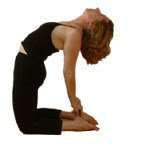When I do Ashtanga yoga, many of the poses I practice are variations from the full expressions of the pose. One pose in particular I have always varied in some form. That pose is Supta Kurmasana or Sleeping Tortoise Pose. I love this pose in its many variations because it tones the spine, creates energy, and refreshes the mind. The full expression of this pose has your feet crossed behind your head as in the pose presented here:

FULL Expression
The full expression is for people with very open hips, hamstrings, shoulders, and lower backs. My openness in these areas varies day by day, just like my students. The most common expression I practice is where I begin to draw my feet together with my hands laying open face behind me. While doing this expression I can wiggle my feet closer together on days when my hips, hamstrings and back are more open or I can wiggle my hands up to catch a strap across my back when my shoulders feel ready. Sometimes a block under my feet can take me a bit deeper. These variations are show here:


Supta Kurmasana Variations
It is important to be aware of how your body is feeling and your breath is a great indicator of how your body is doing. There are practices where your breath is so in sync with your movements that you feel like you can extend yourself in some poses beyond what you might normally do. These are the times to be especially mindful about your subtle ego. All my injuries practicing yoga have involved that subtle ego which lures you into a place of pushing yourself potentially beyond your edge. My own personal example is Supta Kurmasana. My teacher has often helped me to position my feet together. I was feeling very strong, relaxed and in sync with my breath one day. As I wiggled my feet together I stopped short of where I would normally position my feet. My teacher began to help me as I indicated with a smile that some assistance would be good because my subtle ego wanted to go farther. She helped me gently as I requested and moved by feet not too far, but my left hamstring and lower back responded with a spasm and strain. I nursed my injury for two weeks with gentle yoga, relaxation, swimming, and walking. We learn from our mistakes, but it made we wonder how many times I must learn to leave my ego at the door.
I encourage everyone to not be attached to how far they can get into a full expression of a pose and to let go of poses they may not be comfortable doing at all. It doesn’t matter whether you can pretzel yourself into a pose or push yourself all the way to your edge. It’s about uniting your mind, body, and spirit. The only requirements are to act and be attentive to your actions. You will find that yoga not only provides physical benefits without full expression of poses, but it can calm your mind, increase your concentration, and give you the ability to cope with stress. It is a system for your personal development that promotes physical and spiritual well-being.
Remember, you must begin yoga from where you are every day and your point of departure will always be different. So set you starting point based on your condition at the present moment, make your yoga practice sensible and well structured, and construct a gradual and intelligent course for your practice. There is no competition in yoga; there is only where you are, where you are going and where you will be. Be sure to leave your ego at the door!




